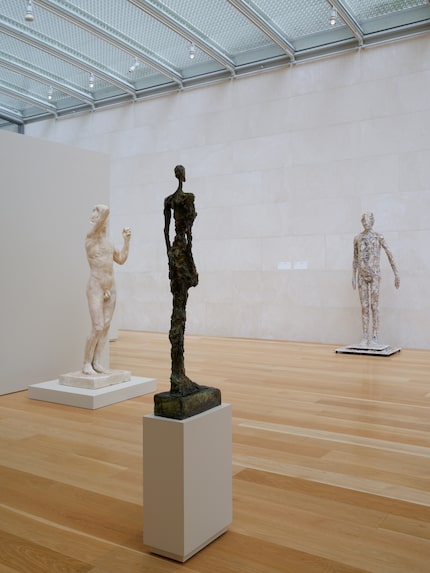Elegant as it is — with travertine-clad, skylit pavilions by architect Renzo Piano, gardens laid out by Peter Walker — the Nasher Sculpture Center isn’t a huge place. With selections from the permanent collection sharing space with special exhibitions, you might think in-house holdings would be relatively limited.
You’d be wrong. Indeed, the current show, “Generations: 150 years of Sculpture,” demonstrates the Nasher’s extraordinary range and depth of modern works.
Based on a substantial collection of modern sculpture assembled over 40 years by the late Raymond and Patsy Nasher, the museum that bears their name continues to expand its holdings, notably with recent creations. Of more than 50 works in the current show, 22 were acquired in the last year. Eleven are among 36 works given to the museum by Nancy A. Nasher, daughter of Ray and Patsy, and her husband, David J. Haemisegger.
The show has its share of marquee names: Rodin, Giacometti, Miro, Moore, Oldenburg, Calder. They’re incorporated not for name-dropping but in dialogue with newer works — many quite new — in thematic groupings. The exhibition was assembled and organized by chief curator Jed Morse and colleagues Catherine Craft, Leigh Arnold and Sydney Smith.

d’airain)” (from left), is the show’s earliest work. Alberto Giacometti’s 1956 work “Venice Woman IV (Femme de Venise IV)” and James Sullivan’s 2000 work “Self” are also included.(Kevin Todora / Nasher Sculpture Center)
A circa 1876 Rodin plaster statue of a young man is the show’s earliest work. Its antecedents can be traced back to Greco-Roman statuary, but immediate inspirations came from Donatellos and Michelangelos that Rodin saw during a visit to Italy. Modern anxieties, though, are suggested in the strained facial expression, the left hand clenched, the right clutching the top of the head.
Giacometti’s familiar stylizations, in elongated, rough-textured figures, are represented by examples large and small. The human figure is still clearly defined in James Sullivan’s slender 2000 Self, but here rendered in a prickly mix of plaster, steel, straw, wood and pigment. By contrast, Dallas artist Frances Bagley’s Centrifugal Torso, from 1990, is abstracted in a construction of black jabs and spirals.
The enduring influence of surrealism, with its unsettling mixes of imagery, is evident in a work by another Dallas artist, the late David McManaway. Ahab, from 1989, poses a square shadow box head atop a body of an inverted Y-shaped branch. Chain of Missing Links by the Pakistani-American sculptor Huma Bhabha, is a tall totemic presence assembled from Styrofoam, clay, wire and what have you, with an animal-skull crotch and inverted architectural brackets posed as feet.

Another group of works is loosely collected around the theme of voids. Tony Cragg’s Glass Instruments is a tabletop assembly of empty glass vessels eroded to a matte whiteness. Drained of contents, scrubbed of obvious glassy identity, they exert a ghostly presence.
That modern sculpture can be exquisitely beautiful is demonstrated by Tony Marsh’s Perforated Vessel, Still Life Series. Glazed earthenware shapes, finely perforated, are clustered on a platter like abstracted fruits.
Technology, a sometimes unsettling leitmotif in modern art, is represented by one of Jean Tingueley’s Rube Goldberg contraptions, Radio No. 1, that, with a curator’s helping hand, spins a wheel and lurches left and right.
Welcome to Warkworth Farm: This Side Paradise, by former SMU art prof Michael Corris, is a floorstanding triptych with LED lights spelling out tricky texts. On the left, run-together letters read, “WH AUDEN WROTE THIS FOR YEATS.” The right-hand panel shows the same text with letters jumbled in encrypted form, and the central panel an encrypted quote from the English poet’s tribute to the earlier Irish poet.

“Culture Meets Nature” nominally labels a downstairs grouping. Magali Reus’ Bonelight (Cascade) stretches the rubric with deconstructed and reassembled elements of a metal picnic table. A small inset photo of a grape cluster presumably establishes the “nature” connection. In Joseph Havel’s Drought an arc of wooden chairs deconstructs as it returns to nature, terminating with craggy branches extending hopeful spoons.
Finally, the glassed-in gallery downstairs explores — quite loosely — “Rhythms of Nature.” Nathan Carter’s 2011 Brooklyn Street Treasures takes up where the adjacent Calder 10 – 5 – 4 leaves off. In effect, Calder’s elegant balancing act is atomized in bright colored shards dangling off an apparently random network of fine wires.
Slip of the Tongue, by 2022 Nasher Prize winner Nairy Baghramian, is an ambiguous assembly of big bonelike shapes, displayed vertically and horizontally, inside and outside a vitrine. The show yields to two dimensions in Claes Oldenburg’s almost abstract Proposal for Colossal Monument in the form of a Butter in a Baked Potato. Three Phyllida Barlow acrylics on paper are such physical presences that they look ready to burst into three dimensions at any moment.
Details
“Generations: 150 Years of Sculpture” runs through Aug. 24 at the Nasher Sculpture Center, 2001 Flora St., Dallas. Wednesday through Sunday from 11 a.m. to 5 p.m. $10, $8 for DART riders, $7 for seniors, $5 for educators and students. Free for children under 12, military, first responders and SNAP EBT card holders. 214-242-5100, nashersculpturecenter.org.

